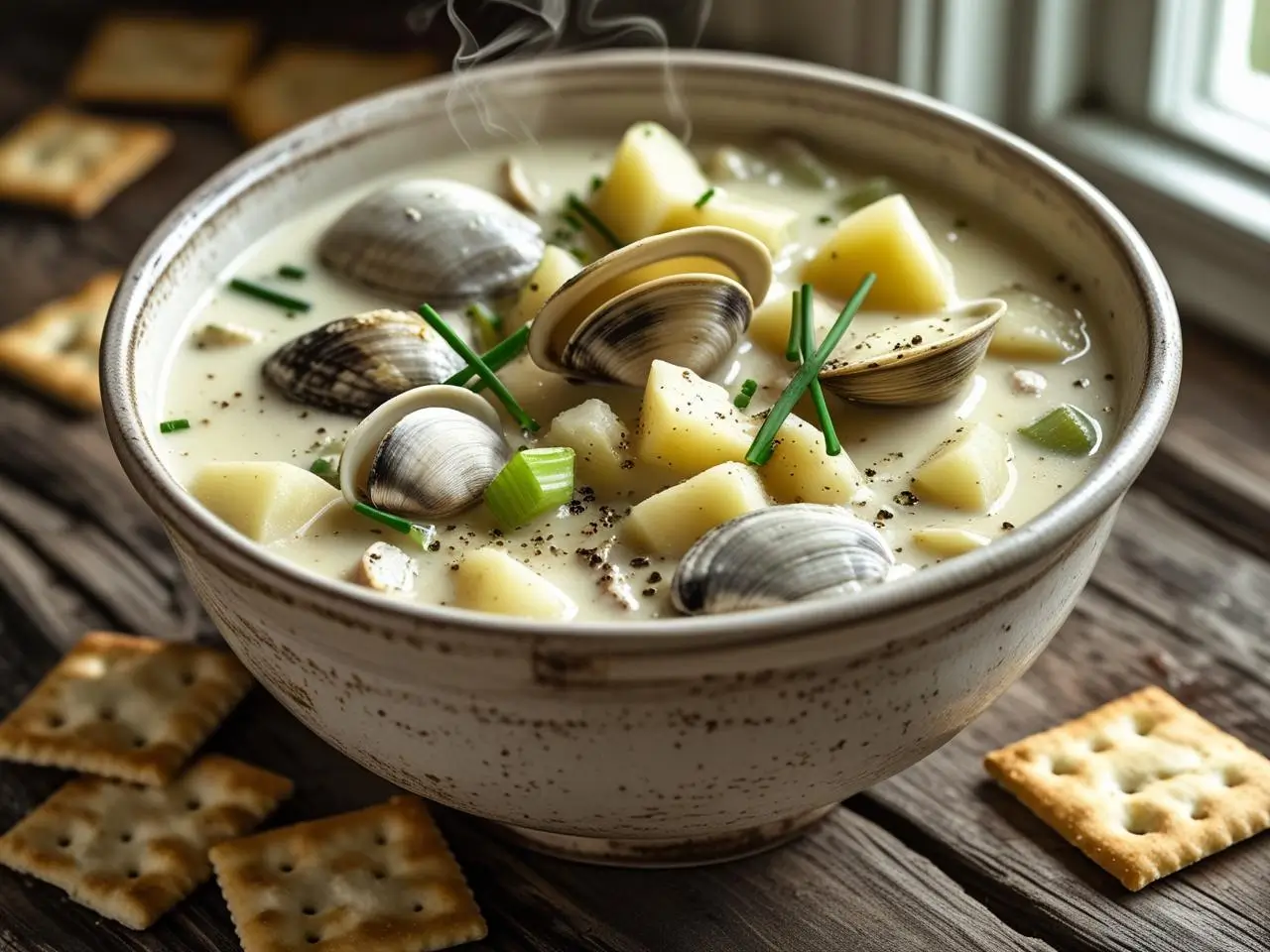Tired of watery, flavorless clam chowder that lacks the rich, creamy texture you crave? You’re not alone. Most home cooks struggle with achieving that perfect balance of tender clams, velvety broth, and chunky vegetables that makes restaurant-quality chowder so irresistible, just like mastering the perfect sauce consistency in dishes such as Mongolian beef or achieving the ideal crispy coating on chicken parmesan.
This comprehensive guide will transform your clam chowder from disappointing to extraordinary. Using professional techniques I’ve refined over 15 years as a culinary instructor specializing in seafood cuisine—the same attention to detail that creates perfect carrot cake cupcakes or flavorful teriyaki meatballs—you’ll learn how to create thick, restaurant-quality clam chowder that rivals New England’s finest establishments.
Why This Clam Chowder Recipe Works
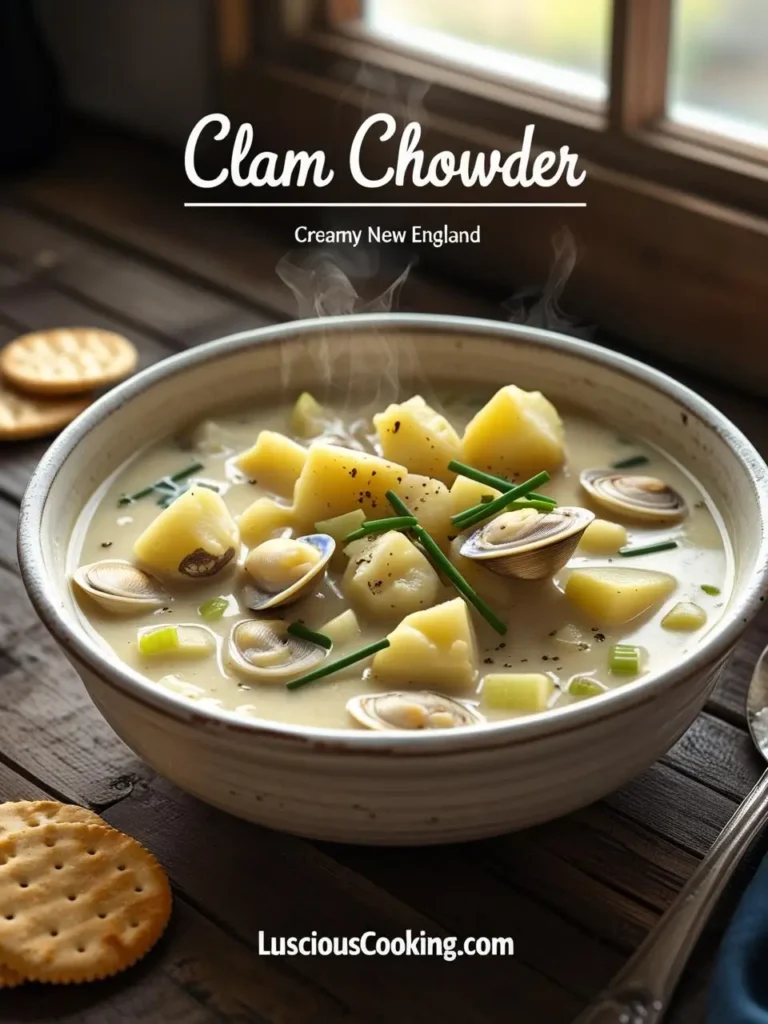
This recipe delivers consistent, professional results because it focuses on three critical elements: flavor development, proper technique, and ingredient quality. Here’s what sets it apart:
- Uses fresh or high-quality canned clams: Both options work beautifully when handled correctly, making this recipe accessible year-round
- Builds flavor in layers: Each step adds depth, from rendering salt pork to deglazing with wine
- Achieves perfect thickness naturally: No flour lumps or gummy texture—just silky, rich consistency
- Balances convenience with quality: Ready in 45 minutes, but tastes like it simmered all day
- Scales easily for crowds: Perfect for intimate dinners or large gatherings
The secret lies in understanding how each ingredient contributes to the final dish. Unlike many recipes that rush the process, this method respects traditional techniques while incorporating modern efficiency.
Choosing the Right Clams
Best Clam Types for Clam Chowder
Fresh littleneck or cherrystone clams work exceptionally well for homemade chowder. Littlenecks offer tender, sweet meat perfect for chunky texture, while cherrystones provide more substantial bites with robust ocean flavor. For convenience without sacrificing quality, premium canned clams like Bar Harbor or Bumble Bee work beautifully, much like how quality ingredients elevate dishes such as Greek salad or chicken korma.
Buying Tips for Fresh Clams
Look for tightly closed shells or clams that snap shut when tapped—this indicates freshness and vitality. Fresh clams should smell like clean ocean water, never fishy or sour. Purchase from reputable fishmongers and use within 24 hours for optimal flavor. Store in the refrigerator covered with damp paper towels, never in sealed containers or fresh water—the same attention to freshness that makes tomato avocado salad shine or ensures oatmeal cookies stay perfectly chewy.
Smart Substitutions
When fresh clams aren’t available, quality frozen clam meat works excellently. Thaw completely and reserve any liquid for your chowder base. Canned clams offer convenience—choose brands packed in clam juice rather than water for enhanced flavor. For budget-friendly options, combine fresh and canned clams to stretch premium ingredients while maintaining taste quality.
Clam Chowder Ingredients & Prep
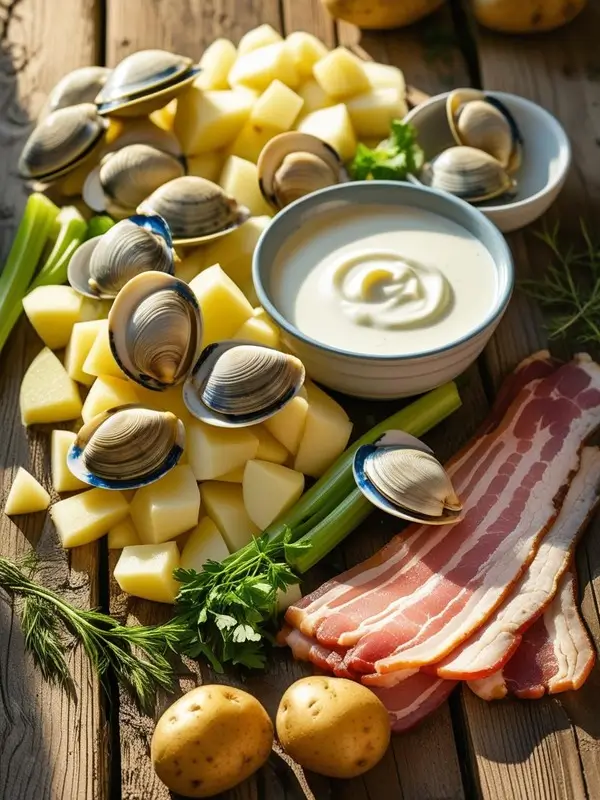
Essential Clam Preparation
Fresh clams require thorough cleaning before cooking. Scrub shells under cold running water, removing any sand or debris. Purge clams in salt water for 30 minutes to eliminate internal sand. For shucked clams, inspect each piece for shell fragments and reserve the precious clam juice—it’s liquid gold for your chowder base.
Building Your Flavor Base
Start with quality salt pork or thick-cut bacon, diced into small cubes. This renders flavorful fat that forms your cooking foundation. Yellow onions, celery, and fresh thyme create the aromatic base, while bay leaves add subtle depth. Quality butter enriches the roux, and heavy cream provides luxurious richness without masking delicate clam flavors.
Pantry Staples That Matter
Use Yukon Gold potatoes for their creamy texture and ability to hold shape during cooking. All-purpose flour creates the perfect thickening roux when properly cooked. Dry white wine adds acidity that brightens the overall flavor profile. Fresh black pepper, not pre-ground, makes a noticeable difference in the final dish’s complexity and warmth.
Clam Chowder Step-by-Step Cooking Instructions
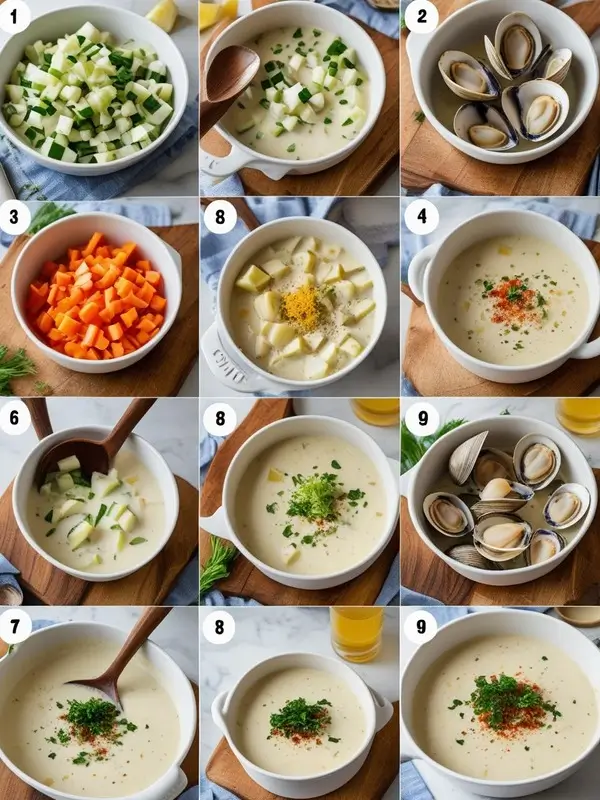
Pre-Cooking Preparation
Begin by rendering salt pork or bacon in a heavy-bottomed pot over medium heat until crispy, about 8-10 minutes. Remove crispy bits but leave the rendered fat—this becomes your flavor foundation. Dice vegetables uniformly for even cooking, and have all ingredients measured and ready. Room temperature ingredients blend more smoothly and cook more evenly—the same principle that creates perfectly golden caramelized onions.
Building the Base
Sauté diced onions and celery in the rendered fat until softened and translucent, approximately 5-6 minutes. Add minced garlic during the final minute to prevent burning. Sprinkle flour over vegetables and cook for 2-3 minutes, stirring constantly to create a blonde roux that eliminates raw flour taste while providing thickening power.
Adding Liquids and Simmering
Gradually whisk in clam juice and white wine, ensuring no lumps form. Add diced potatoes, bay leaves, and fresh thyme. Bring to a gentle simmer and cook until potatoes are fork-tender, about 15-18 minutes. Maintain a gentle bubble—aggressive boiling can break down potatoes and create a gritty texture.
Finishing with Cream and Clams
Reduce heat to low and gradually stir in heavy cream to prevent curdling. Add clams during the final 3-4 minutes of cooking to prevent toughening—overcooked clams become rubbery and unpalatable. Taste and adjust seasoning with salt, white pepper, and a splash of hot sauce if desired. Remove bay leaves before serving.
Pro Tips for Perfect Clam Chowder
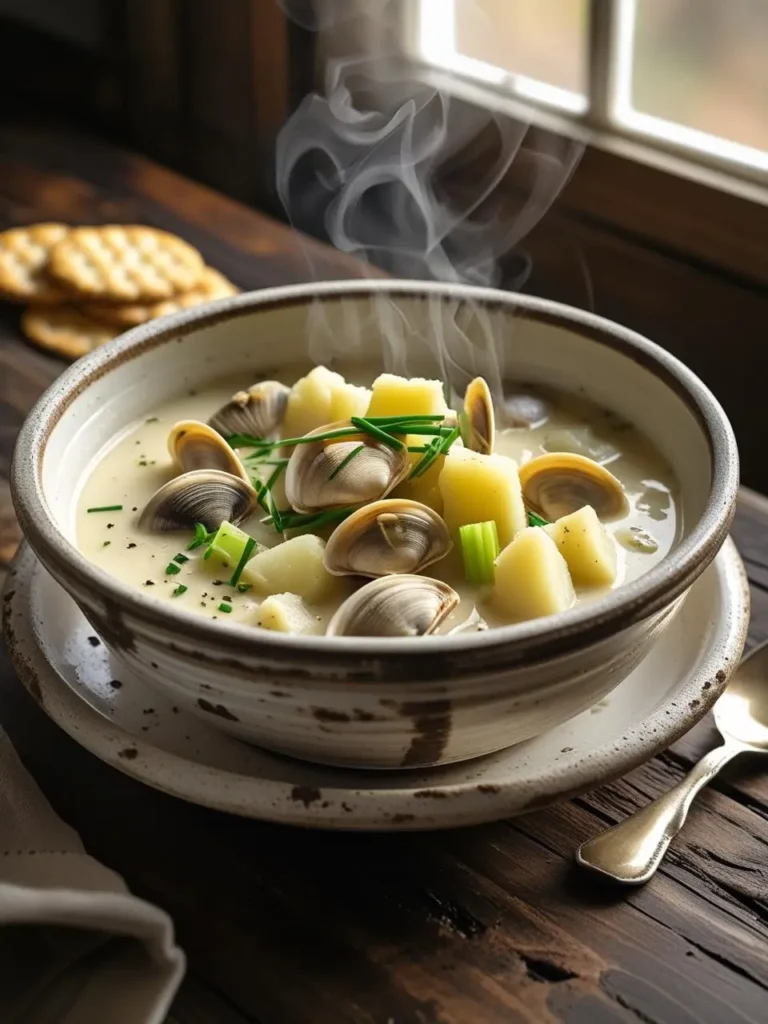
Avoiding Common Texture Problems
Never boil chowder after adding cream—this causes curdling and separation. If your chowder seems too thin, create a slurry using equal parts cold water and flour, then whisk it in gradually. For overly thick chowder, thin with additional clam juice or warm milk rather than water, which dilutes flavor, similar to how maintaining proper sauce consistency elevates dishes like easy taco salad.
Clam Chowder Essential Tool Recommendations
A heavy-bottomed Dutch oven distributes heat evenly and prevents scorching. A fine-mesh strainer removes any shell fragments from clam juice. Wooden spoons won’t scratch your pot’s surface and allow gentle stirring. An immersion blender can partially puree vegetables for extra body while maintaining a chunky texture.
Clam ChowderStorage and Reheating Secrets
Cool chowder completely before refrigerating, where it keeps for 3-4 days. Reheat gently over low heat, stirring frequently to prevent separation. Add a splash of cream or milk if needed to restore the original consistency. While chowder can be frozen for up to 2 months, cream-based soups may separate upon thawing—whisk vigorously to re-emulsify.
Clam Chowder Flavor Variations

New England vs Manhattan Style
Traditional New England clam chowder features cream-based broth, while Manhattan style incorporates tomatoes for a completely different flavor profile. Rhode Island clear chowder uses neither cream nor tomatoes, highlighting pure clam flavor in a clear broth. Each regional variation has passionate defenders and distinct preparation techniques—you can explore another excellent New England approach at AllRecipes’ My Best Clam Chowder.
Lightened Health-Conscious Version
Substitute half-and-half for heavy cream to reduce calories while maintaining richness. Use turkey bacon instead of salt pork for lower fat content. Add extra vegetables like carrots and parsnips for nutrition and fiber. Greek yogurt stirred in at the end provides tang and protein without cream’s heaviness.
Gourmet Elevated Variations
Add fresh corn kernels for sweetness and texture contrast. A splash of dry sherry enhances the seafood flavors beautifully. Fresh herbs like chives, dill, or parsley brighten the finished dish. Smoked paprika adds subtle smokiness, while a dash of Old Bay seasoning provides classic Mid-Atlantic flavor complexity.
Clam Chowder Serving Suggestions
Serve clam chowder in warmed bowls to maintain its temperature longer. Classic accompaniments include oyster crackers, crusty sourdough bread, or warm buttermilk biscuits for dipping. A simple green salad with vinaigrette provides a refreshing contrast to the rich chowder.
For wine pairings, choose crisp white wines like Sauvignon Blanc, Pinot Grigio, or unoaked Chardonnay that complement without overwhelming delicate clam flavors. Light beers such as pilsners or wheat beers also pair beautifully. For special occasions, a glass of champagne creates an elegant combination.
Consider garnishes that add visual appeal and flavor contrast: a drizzle of good olive oil, fresh chives, crispy bacon bits, or a sprinkle of smoked paprika. These simple touches transform homemade chowder into a restaurant-quality presentation.
FAQs
Can I use frozen clams for this recipe? Absolutely! Thaw frozen clam meat completely and reserve any liquid for your chowder base. Frozen clams work particularly well since they’re often flash-frozen at peak freshness. Just remember to add them during the final few minutes of cooking to prevent toughening.
How do I fix chowder that’s too thin? Create a slurry using equal parts cold water and flour, then whisk gradually into simmering chowder. Alternatively, remove some potatoes, mash them, and stir them back in for natural thickening. Always adjust thickness gradually—you can add more thickener, but removing it is impossible.
Is this recipe safe during pregnancy? Yes, when using properly cooked clams. Ensure fresh clams reach an internal temperature of 145°F, and canned clams are heated thoroughly. Pregnant women should avoid raw or undercooked shellfish, but properly prepared clam chowder is perfectly safe and nutritious.
MORE RECIPES
Conclusion
Mastering clam chowder requires understanding fundamental techniques, quality ingredients, and patient execution. These seven professional secrets—from proper clam selection to gentle cooking methods—will transform your homemade chowder from ordinary to extraordinary.
The beauty of great clam chowder lies in its simplicity and respect for ingredients. When you layer flavors thoughtfully, handle clams gently, and finish with care, you create something truly special that brings comfort and satisfaction to every bowl.
Ready to create your restaurant-quality clam chowder? Gather your ingredients and start building those flavor layers tonight! For more inspiration, check out these excellent clam chowder variations from Damn Delicious, AllRecipes, The Cozy Cook, and Tastes Better From Scratch to explore different approaches and find your perfect version.
Join thousands of home cooks who’ve discovered the joy of homemade clam chowder—your family will thank you for this comforting, soul-warming masterpiece!

